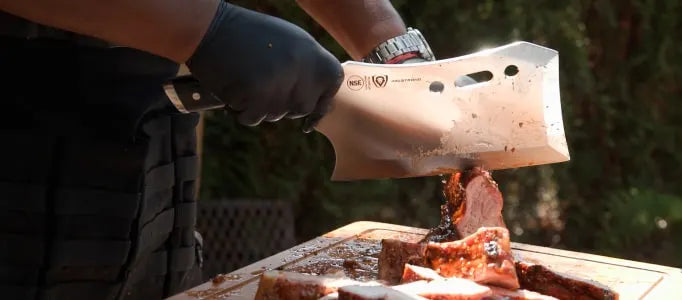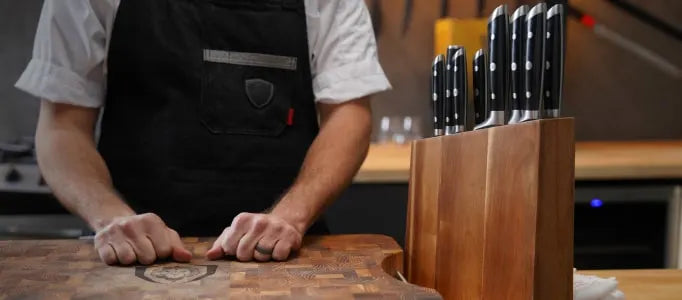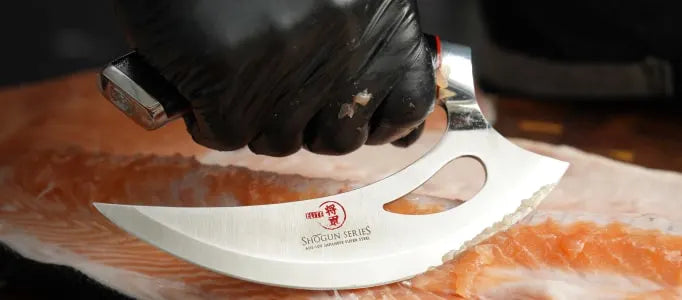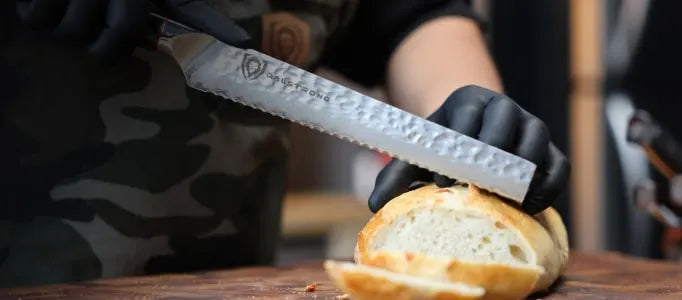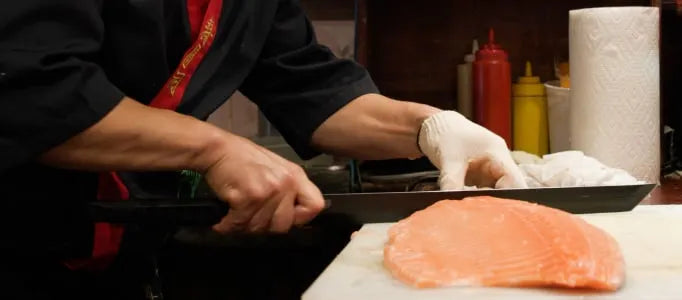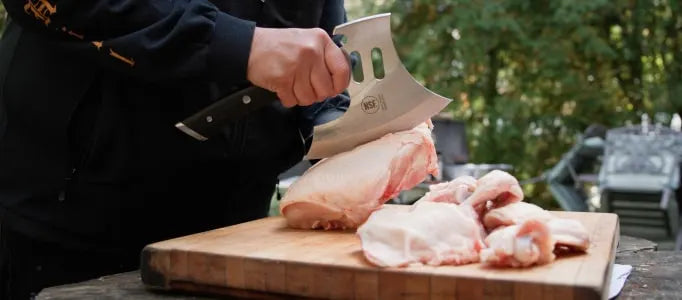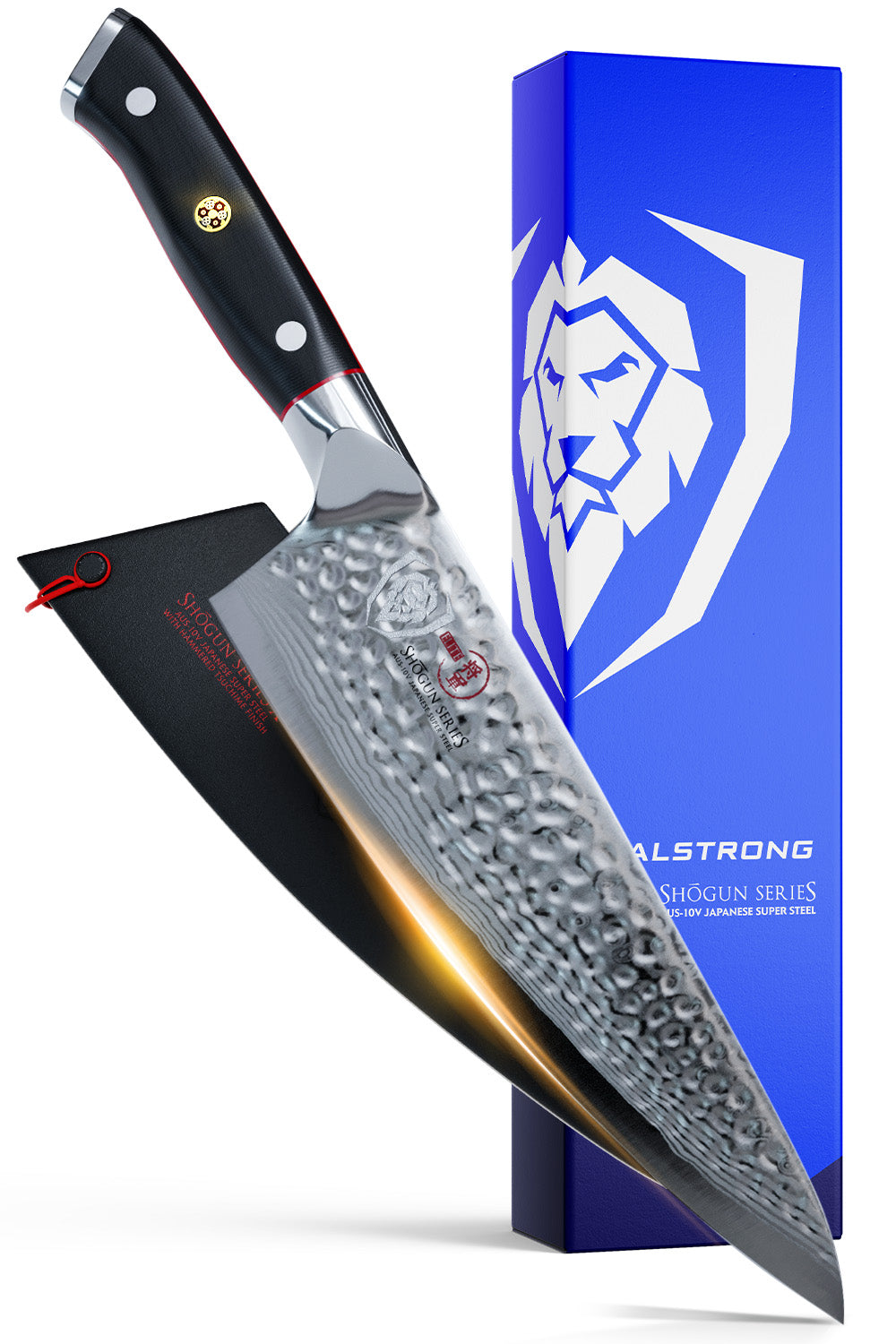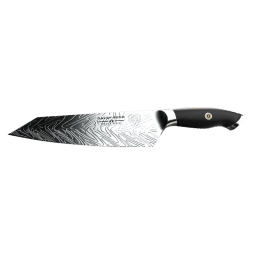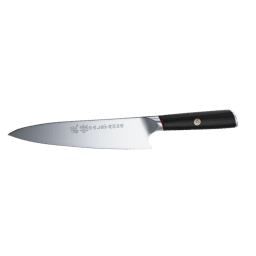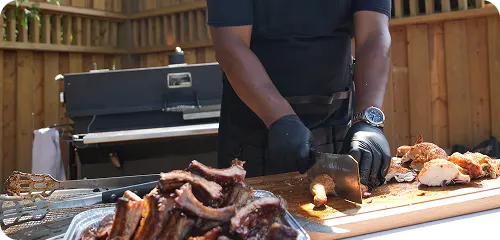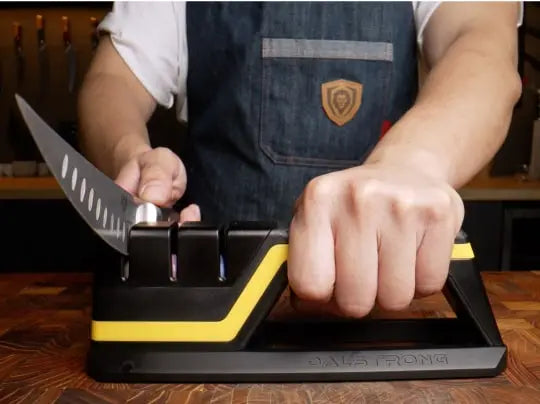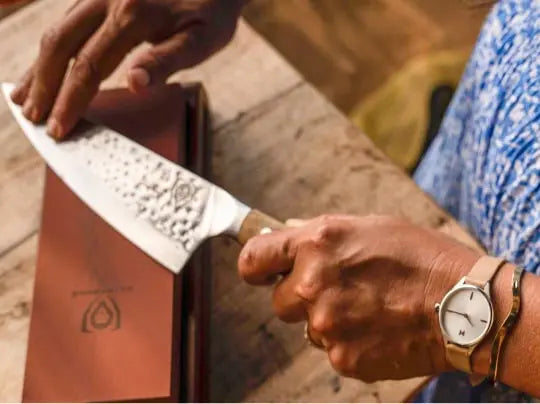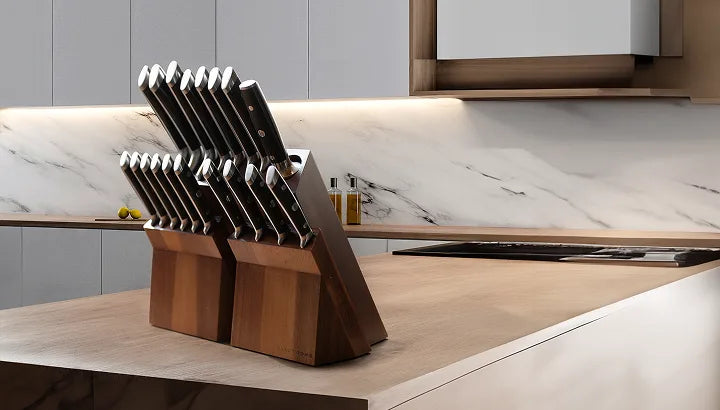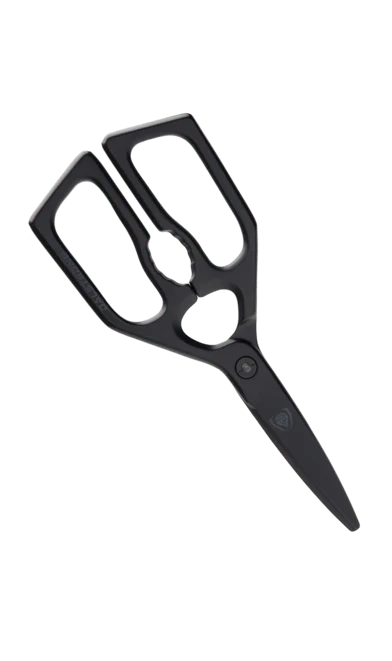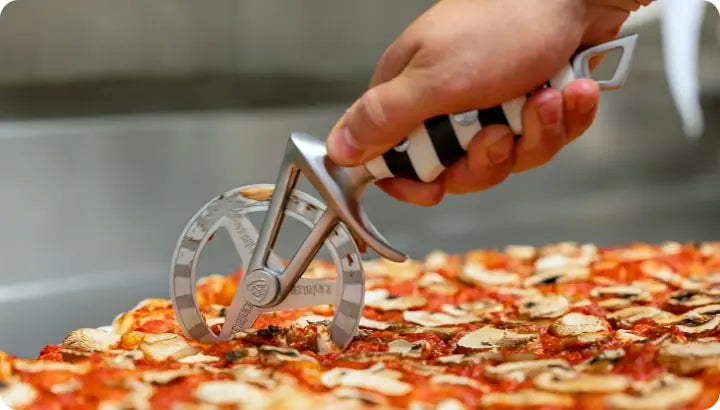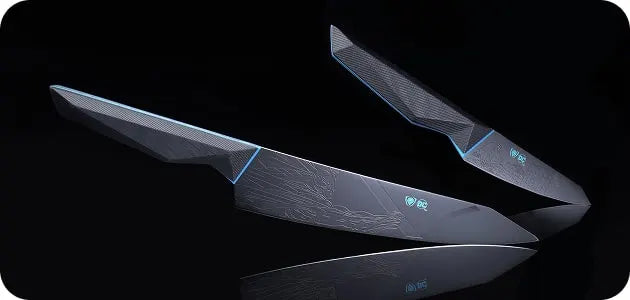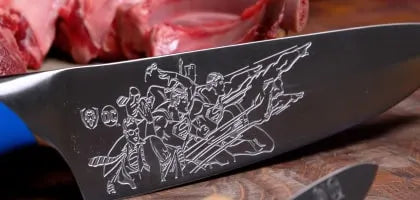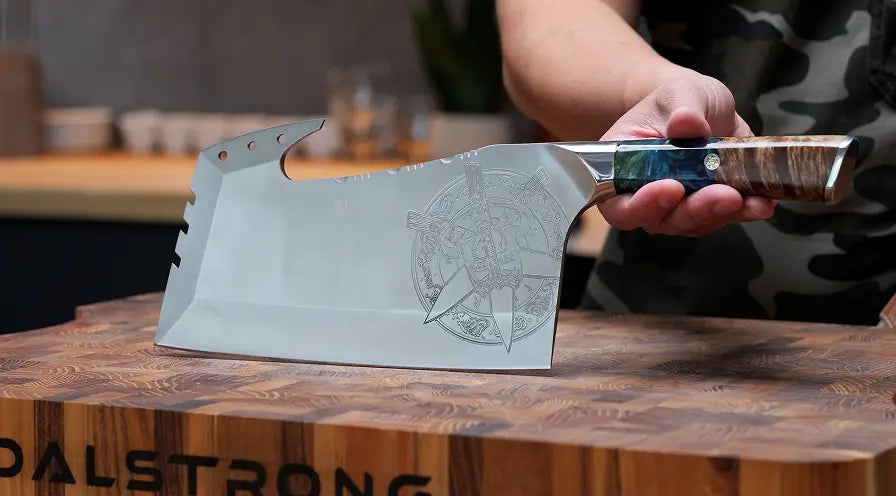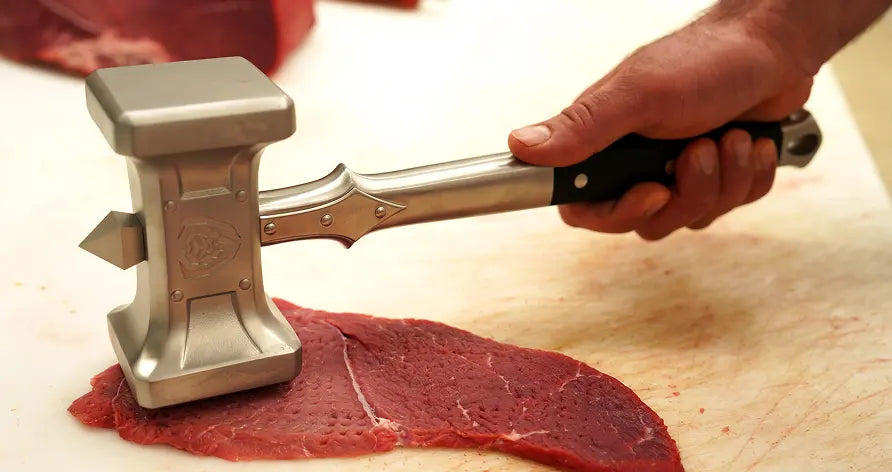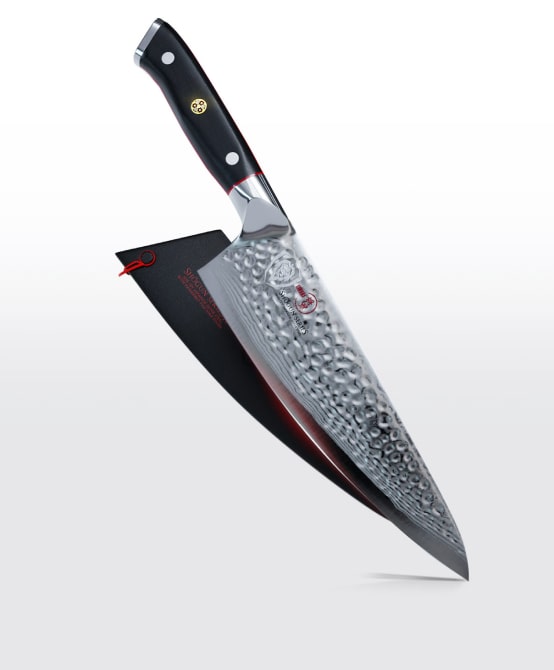
How to Mince Garlic:
- Cut off the root end of the garlic clove.
- Tap the clove with a jar so that its peel splits.
- Use your fingers to remove the peel.
- Use the tip of the knife to cut thin vertical slices into the peeled garlic.
- Make a horizontal slice through the center of the garlic clove.
- Make thin slices crosswise in order to mince the garlic into small pieces, then chop garlic back and forth.
Content Table :
- Mincing vs. Chopping
- How to Mince Garlic
- Knife Recommendations for Mincing Garlic
- Frequently Asked Questions
1. Mincing vs. Chopping

The world of cooking is filled with recurring questions that pop up over and over again. And one of those questions is... what’s the difference between mincing garlic and chopping garlic, anyway?
The terms are often used interchangeably but they actually differ in some important ways. Your method for cutting fresh garlic will undoubtedly have an effect on the taste of your food, as well as the consistency and texture. It’s important to be clear, in a recipe, whether you’re looking for chopped garlic or minced garlic.
Chopping is part of mincing, yes, but the end result is different in important ways. Physically, the difference is actually extremely simple: size. A mince is much finer than a chop. Minced garlic is less than 1/16 inch in diameter, while chopped garlic is typically no more than an ⅛ inch. And while this difference might seem superficial at first, it actually has a pretty profound impact.
Imagine, for example, that you use chopped garlic in a dish that calls for minced garlic. The chopped garlic is bigger, and it will take longer to cook than the recipe you’re following. Since it won’t cook long enough for its size, you will be eating raw garlic. The flavor will be pungent and, frankly, pretty gross. Nobody likes that raw garlic flavor.
Whether you are using a baking dish, instant pot, skillet, or stock pot, everyone can agree that garlic adds that something extra to almost every meal.
Now that we know what minced garlic is, let’s talk about kitchen tips and learn how to mince garlic.
2. How To Mince Garlic
4'' Paring Knife | Phantom Series | Dalstrong ©
For this article, we’re going to be focusing on mincing by hand. You could use a tool like a garlic press or a grater and quickly get very fine pieces of minced garlic, but let’s say you find yourself without your tools. You need to be able to know what to do! It’s also good to build up your knife skills in the kitchen, in order to preserve the flavor and keep your recipe from being ruined.
The best tool for mincing garlic by hand is a chef knife or a santoku knife. It will provide the necessary heft and size to maneuver the garlic properly. So our recommendation is a 7 inch chef or santoku knife at a minimum (for more ideas on knives for mincing garlic, check out our list below).
Mincing garlic is easier than you think. So place your cutting board down and let’s get to work.
- Using your chef’s knife, cut the cloves at the top of the root.
- Place a garlic clove on your cutting board and gently tap on it with a jar or a glass until its peel splits.
- Use your fingers to peel the garlic and remove the papery skin.
- Grip your chef’s knife firmly, and then use the tip of the knife to cut thin vertical slices into the peeled garlic clove. Make sure to leave it attached at the root end.
- Now, very carefully turn the knife and make a horizontal slice through the center of the garlic clove. Once again, we’re making sure to leave it attached at the root end.
- Finally, make thin slices crosswise in order to mince the garlic into small pieces. Chop garlic back and forth until you have the size of minced garlic you’re looking for.
See? It sounds daunting, but it’s much easier than you probably imagined. That’s how you peel and mince garlic by hand, which is a tool that will certainly come in handy for any garlic lover.
3. Knife Recommendations For Mincing Garlic
Now you know how all about cutting garlic, so your next step is to pick up the appropriate tool for the job. As with any kitchen task, we’re looking for a knife that will maximize the experience and make it as effortless as possible, as well as enhancing your delicious garlic recipes like garlic bread for instance.
So pick up a cutting board and one of these excellent knives. Don't worry, you don't need above average knife skills and you can use these kitchen knives for a lot more than just peeling and mincing garlic.
1. Chef's Knife 8" | Phantom Series | Dalstrong ©
A chef’s knife is one of the best options for mincing garlic, its size working perfectly with the motion of your wrists. This 8-inch chef’s knife from Dalstrong’s Phantom Series is not only a great tool to cut watermelon, it’s also an extremely versatile kitchen knife that will help you conquer just about any recipe.
PROS:
- Precision-forged 8” blade with premium Japanese AUS-8 steel.
- Features divots to minimize friction and stuck on your food, as well as a curved blade to easily guide it through a cut. Perfect for mincing garlic.
- This is an extremely sharp blade, hand-finished to a mirror polish within 13-15 degrees.
- Premium quality laminated Spanish pakkawood handles, giving the knife an elegant look.
CONS:
- It’s a bit on the lighter side for a chef’s knife, which could be a strength for activities such as chopping and mincing.
- If you’re looking for a bigger chef’s knife with even more premium features, check out Chef's Knife 9.5" | Shogun Series | Dalstrong ©.
2. Santoku Knife 7" | Quantum 1 Series | Dalstrong ©
The word “Santoku” means “three uses,” and it refers to this knife’s abilities for slicing, dicing, and mincing. Just like chef knives, Santoku knives make for excellent all-around kitchen tools, making life easier for you on just about every kitchen task.
PROS:
- Precision forged, ultra sharp, wear resistant, single-piece, high carbon American BD1N-VX steel
- The edge is hand-sharpened to 16-18° per side for a great balance between sturdiness and sharpness.
- Military-grade G10 and carbon fiber hybrid handle, extremely comfortable and easy to use.
- Features Dalstrong’s “Nova Prime” blade pattern, which not only looks amazing, but also helps reduce drag and increases efficiency.
CONS:
- This Santoku knife is a bit on the heavy side, which some home cooks might not prefer.
- This premium quality knife is toward the upper end of the price range represented on this list.
3. Serbian Chef's Knife 7.5" | Gladiator Series | NSF Certified | Dalstrong ©
Just look at this thing! This is a powerful kitchen implement that isn’t just perfect for chopping and mincing vegetables but will also help you with heavy-duty kitchen tasks. The perfect combination of a chef’s knife and a cleaver. And (this is not a minor point) it is extremely cool-looking.
PROS:
- Made of precision-forged, wear resistant, single-piece, high carbon German ThyssenKrupp Steel at 56+ Rockwell hardness. Powerful steel for a powerful performance.
- A hammered finish helps it sail through culinary challenges with minimal drag or stuck on food.
- Premium quality, laminated G10 Garolite handle.
- A menacingly attractive knife from a visual standpoint, will surely inspire curious remarks from onlookers.
CONS:
- Of course, if you like your knives to look more understated, look elsewhere. This knife is an eye-catcher.
- Just like most cleavers, its heft is part of its power. This is certainly a heavier knife than most chef’s knives, which may not be quite your bag.
Remember how we said you should pick up a cutting board and also a knife? Well, this incredible bundle brings two premium-quality products together at an amazing value.
PROS:
- This is a fantastic knife, made of high carbon German ThyssenKrupp Steel at 56+ Rockwell.
- The blade features a beautiful hand-polished satin finish, as well as a Granton style edge.
- The cutting board is also high quality, made of sustainably sourced Tropical Teak wood with satin finished handles.
- One of the best gifts you can possibly give. Be the hero at the next housewarming get-together you attend.
CONS:
- This knife does have a bit of flex, which makes it perfect to cut watermelon with but might have a hard time with tough cuts of meat.
- If you already have a quality cutting board, you won't need the bundle.
5. Paring Knife 3.5" | Frost Fire Series | Dalstrong ©
Paring knives are also a great choice for working with garlic, and this is an absolutely stunning piece from Dalstrong’s acclaimed Frost Fire series.
PROS:
- The blade is made of 7-layer high-carbon, high-chromium 10CR15MOV steel with added cobalt.
- The sandblast finish gives it a “frosted” look that is not only visually appealing but also enhances its non-stick properties.
- Premium quality white resin handle with a slender, ergonomic design.
- An incredible gift for the knife lover in your family.
CONS:
- Its sleek look and unique handle design may not be everybody’s cup of tea.
- Of course, it is a paring knife, so keep that in mind when you’re considering purchasing this; it’s not a large all-purpose chef knife.
4. Frequently Asked Questions About Mincing Garlic
8.5'' Kiritsuke Chef Knife | Omega Series | Dalstrong ©
How do you store minced garlic?
You can store your leftover fresh minced garlic in the refrigerator in an airtight container, or in a zipped lock bag. It won’t stay fresh for too long, so try to use it as soon as possible in order to avoid wasting it. Its flavor will gradually diminish. Throw it out after a week.
What is the difference between minced garlic and garlic paste?
The difference between minced garlic and garlic paste is, basically, time. Minced garlic is very finely chopped, while garlic paste is essentially garlic mush. Different recipes call for different things. Garlic paste is the natural progression of mincing garlic; if you continue mincing, it will eventually turn into a garlic paste (though if it’s garlic paste what you’re after, you might be better off using a food processor).
Can you mince garlic with a grater?
You can mince garlic with a tool called a rasp grater (also known as a microplane). To do this, simply run a clove along the grater. A microplane will produce extremely fine pieces of garlic. An upshot to this method is that it allows you to grate directly over a pan.
Can you mince garlic with a garlic press?
Yes, you can mince garlic with a garlic press. In fact, that’s one of the most popular methods of mincing garlic. However, if you don’t have one in your kitchen, you can mince by hand using a sharp knife.
When to mince garlic?
The best time to mince fresh garlic is right before you add it to a dish. The more time it gets to break down, the more enzymes are released and the more allicin is produced. And yes, this can result in a lot of great flavor, but it can also be overpowering. So it’s best to be swift about it and mince your garlic right after applying it.
What are some of the best garlic recipes?
The list is endless but the most popular would be garlic bread, honey garlic chicken, roasted garlic chicken, instant pot recipes featuring garlic and about a million other methods of adding garlic to your meal planning efforts.
Shop Dalstrong Knives Today
Written by Jorge FarahBorn on the coast of Colombia and based in Buenos Aires, Jorge is a cooking enthusiast and kitchenware obsessive with a tremendous amount of opinions.
